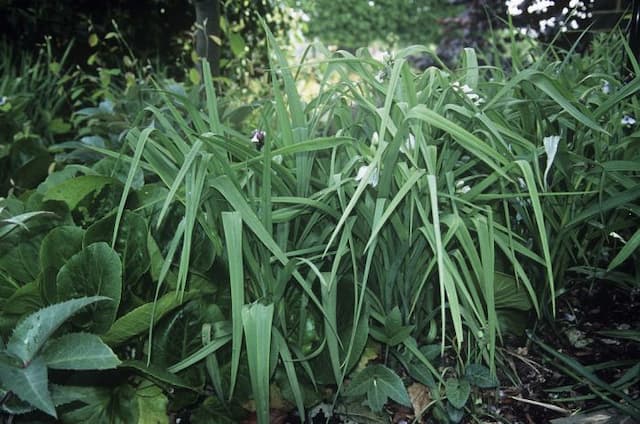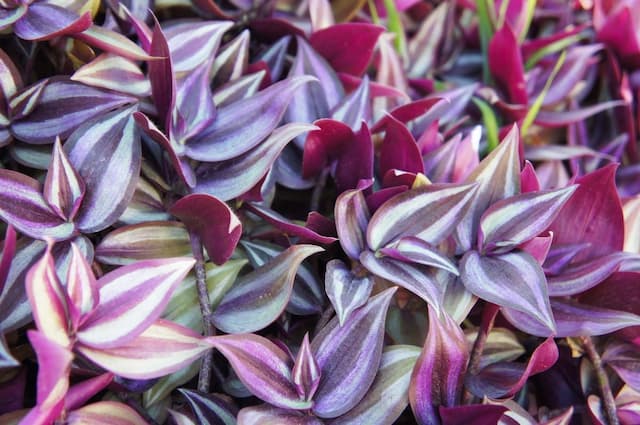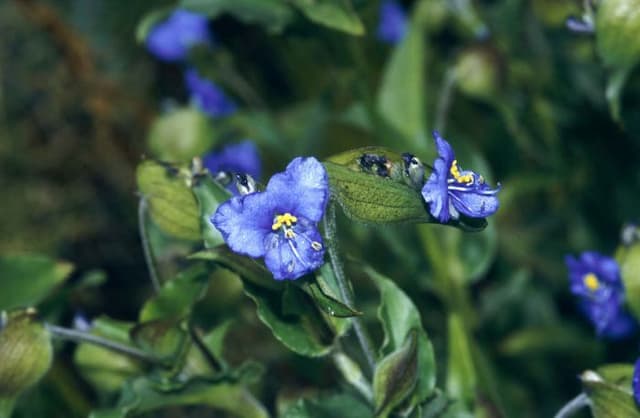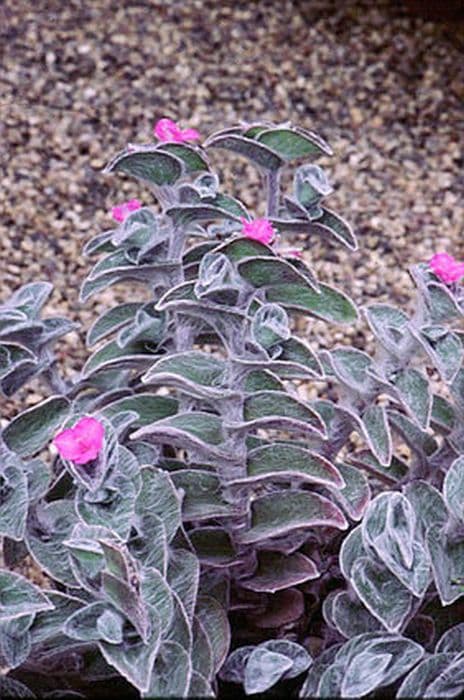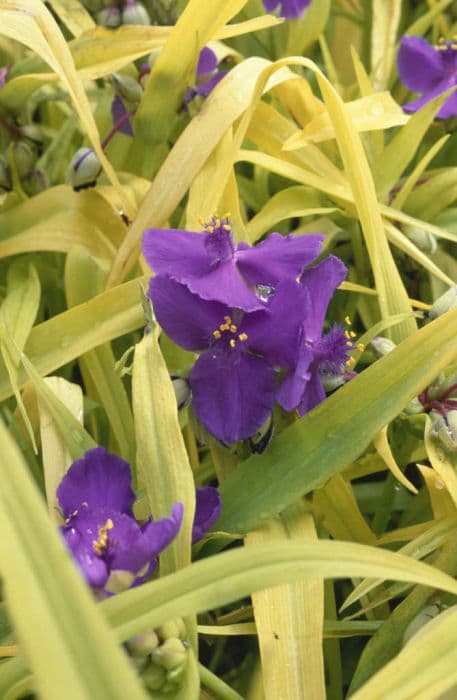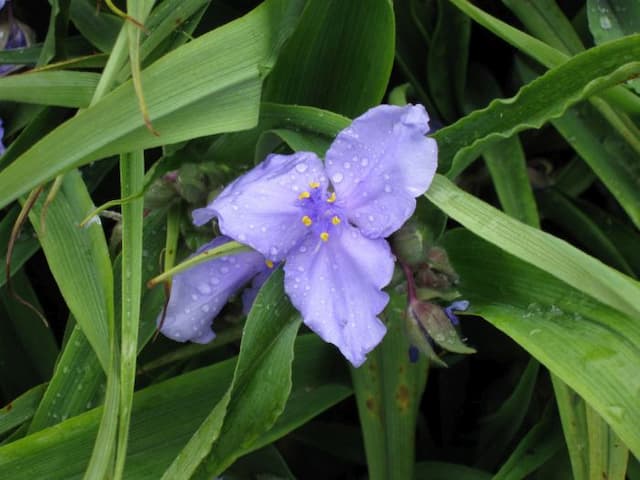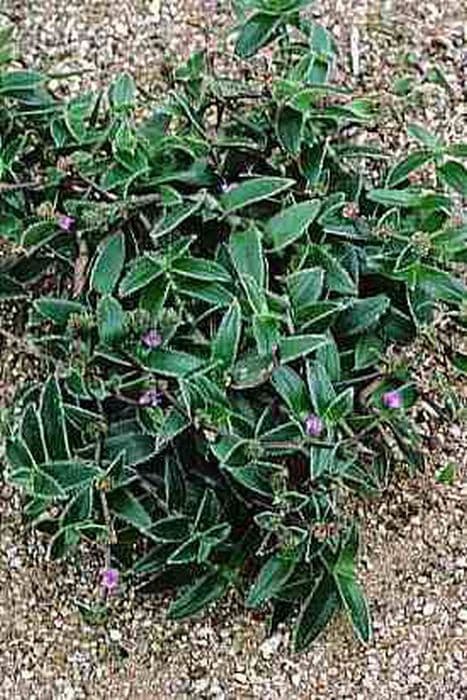Turtle Vine Callisia elegans

ABOUT
Callisia elegans, commonly known as the Elegant Inch Plant, is a foliage plant with a delicate and elegant appearance. It has slender, trailing stems that are adorned with small, oval to round-shaped leaves. The leaves are glossy and have a rich green color with finely striped patterns in different shades of green, which can be more prominent on the new growth. The contrast between the leaf color and the patterning gives the plant a textured look. The Elegant Inch Plant may produce tiny flowers that are not particularly showy, often hidden among the leaves. These flowers can be white or pink, depending on the variety. The overall look of the plant is lush and can add a touch of sophistication to an indoor space or a shaded garden area.
About this plant
 Names
NamesFamily
Commelinaceae.
Synonyms
Dwarf Bolivian Wandering Jew, Turtle Vine, Miniature Inch Plant.
Common names
Spironema elegans, Callisia repens var. elegans.
 Toxicity
ToxicityTo humans
Callisia elegans, commonly known as the Turtle Vine, is not widely recognized for being toxic to humans. However, like many houseplants, it is not intended for consumption, and eating it may cause mild digestive disturbances, such as nausea or vomiting. It is always best to keep plants out of reach of children, who might accidentally ingest plant parts. If large quantities are consumed or if symptoms appear severe, medical attention should be sought.
To pets
In pets, specifically cats and dogs, Turtle Vine can be more problematic. Callisia elegans has been known to cause gastrointestinal upset, such as vomiting or diarrhea, when ingested by pets. This plant might also cause skin irritation upon contact in some animals. If you suspect your pet has ingested any part of this plant, it is advisable to contact a veterinarian. Symptoms may vary depending on the amount consumed, and a vet can provide the appropriate care for your pet's specific needs.
 Characteristics
CharacteristicsLife cycle
Perennials
Foliage type
Evergreen
Color of leaves
Green
Flower color
Pink
Height
0.5 feet (15 cm)
Spread
0.5 feet (15 cm)
Plant type
Herb
Hardiness zones
10
Native area
Central America
Benefits
 General Benefits
General Benefits- Easy to care for: Callisia elegans, also known as 'Chain Plant', requires minimal maintenance, making it suitable for novice gardeners.
- Aesthetic appeal: With its attractive foliage and cascading growth habit, it adds visual interest to indoor and outdoor spaces.
- Rapid growth: The Chain Plant grows quickly, providing instant gratification and the ability to propagate readily from cuttings.
- Versatile placement: It can thrive in a variety of environments, from hanging baskets to terrariums, making it a flexible décor option.
- Non-toxic to pets: Being a pet-friendly plant, it's safe to keep around cats and dogs.
 Medical Properties
Medical Properties- This plant is not used for medical purposes.
 Air-purifying Qualities
Air-purifying QualitiesThis plant is not specifically known for air purifying qualities.
 Other Uses
Other Uses- Callisia elegans, commonly known as the Turtle Vine, can be used to create hanging basket displays in homes or gardens due to its cascading foliage.
- The vibrant green leaves with purple undersides of the Turtle Vine can add an aesthetic appeal as a groundcover in garden landscapes where frost is not a concern.
- Some hobbyists use cuttings from the Turtle Vine to create intricate living sculptures and topiaries when wrapped around wireframes.
- The plant's dense growth can be deployed as a natural privacy screen on balconies or patios when planted in containers and allowed to spill over.
- Aquarists sometimes use Turtle Vine grown emersed (partially in water) to enhance the naturalistic appearance of paludariums or ripariums.
- Turtle Vine can be used in educational settings, such as schools or workshops, to teach principles of plant propagation and horticulture due to its easy-to-root cuttings.
- In mild climates, Turtle Vine can be beneficial as erosion control on slopes or banks due to its mat-forming growth habit.
- The plant can be included in mixed plantings with other species to create varied textures and shades of green in container gardens.
- Crafty individuals may use the vibrant foliage of Turtle Vine to create natural dye for fabrics, although experimentation and mordants are required.
- Photoshoot stylists and filmmakers might use Turtle Vine as a prop to evoke lush, tropical settings due to its quick growth and dense foliage.
Interesting Facts
 Feng Shui
Feng ShuiThe plant_name is not used in Feng Shui practice.
 Zodiac Sign Compitability
Zodiac Sign CompitabilityThe plant_name is not used in astrology practice.
 Plant Symbolism
Plant Symbolism- Resilience: Callisia elegans, also known as the Turtle Vine, has the ability to thrive in various conditions, which makes it a symbol of resilience and adaptability.
- Growth: Due to its rapid and sprawling growth habit, Turtle Vine represents personal growth, expansion, and the idea of spreading out in different directions in life.
- Vitality: With its lively green foliage, Turtle Vine is often associated with vitality and the life force that drives growth and good health.
- Protection: In some cultures, hanging plants like the Turtle Vine are believed to offer protection by absorbing negative energy from the surrounding space.
 Water
WaterThe Inch Plant, also known as Callisia elegans, should be watered thoroughly once the top inch of the soil feels dry to the touch. On average, this might mean watering once a week, but this can vary depending on environmental conditions such as temperature and humidity. Use room-temperature water and apply it until it begins to run out of the drainage holes—this might be approximately 8 to 16 ounces for smaller pots. During the winter months, reduce watering frequency as the plant goes through a period of dormancy. Allow the pot to drain completely after watering to avoid waterlogging.
 Light
LightInch Plants prefer bright, indirect light but can tolerate lower light conditions as well. The best spot for an Inch Plant would be near a window with a sheer curtain or in a room with lots of diffused natural light. Avoid placing it in direct sunlight, as this could scorch the leaves.
 Temperature
TemperatureInch Plants thrive in temperatures between 60 and 80 degrees Fahrenheit but can survive in temperatures as low as 50 and as high as 90 degrees Fahrenheit. The ideal temperature range promotes healthy growth and prevents stress on the plant.
 Pruning
PruningPrune the Inch Plant to encourage bushier growth and to maintain its shape. Trim back leggy stems, especially in the spring, which is the best time for pruning. Pruning can be done every few months or as needed to keep the plant looking tidy.
 Cleaning
CleaningAs needed
 Soil
SoilThe best soil mix for a Turtle Vine includes a well-draining, peat-based potting mix, blended with sand or perlite to improve drainage. This plant prefers a slightly acidic to neutral pH, ranging from 6.0 to 7.0.
 Repotting
RepottingTurtle Vine should be repotted every 1-2 years or when it has outgrown its current pot, to refresh the soil and provide more room for growth.
 Humidity & Misting
Humidity & MistingTurtle Vine thrives in moderate to high humidity levels, ideally between 40-70%.
 Suitable locations
Suitable locationsIndoor
Grow Turtle Vine indoor with bright, indirect light and high humidity.
Outdoor
Place Turtle Vine in a shaded spot outside with protection from direct sun.
Hardiness zone
10-11 USDA
 Life cycle
Life cycleCallisia elegans, commonly known as the Chain Plant, begins its life cycle with seed germination, which requires warmth, moisture, and light to trigger the development of the seedling. After emergence, the seedling enters a vegetative stage, growing stems and leaves as it matures; this plant is known for its trailing vines and small, round, green leaves. Following the vegetative phase, Chain Plant reaches maturity when it starts to produce small, white or pink flowers, usually during spring or summer, signaling its readiness for reproduction. Cross-pollination between flowers, often aided by insects or the wind, results in the production of seeds which, when dispersed, can give rise to a new generation of plants. Chain Plant may also propagate vegetatively through stem cuttings or when its trailing stems touch the ground and root at nodes, forming new plants clonally. As a perennial, the Chain Plant can survive for several years, going through multiple cycles of growth, flowering, and seed production in its lifetime.
 Propogation
PropogationPropogation time
Spring-Early Summer
Propogation: The most popular method of propagating Callisia elegans, commonly known as Turtle Vine, is through stem cuttings. Ideally, propagation is done during the warmer months, such as late spring through early autumn, when the plant is actively growing. To propagate from stem cuttings, a healthy, non-flowering stem is selected. Cut a section of the stem about 4 to 6 inches (approximately 10 to 15 centimeters) in length, making sure it includes several leaves. Remove the lower leaves to expose the nodes, as roots will emerge from these points. The cut end can be dipped in rooting hormone powder to encourage root growth, though this is not strictly necessary. The prepared cutting is then placed in moist potting soil or water until it develops sufficient roots, at which point it can be potted into soil. The soil should be kept consistently moist but not waterlogged. With proper care, the cutting will soon establish a new root system and begin to grow, eventually forming a new Turtle Vine plant.
